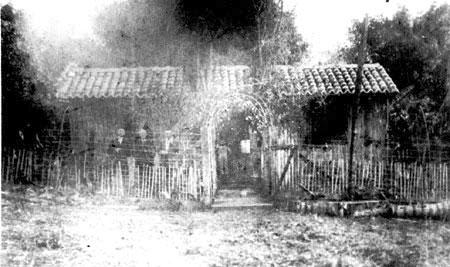
A woman dressed in traditional hoop skirt walks past graves marked with Confederate flags in the American Cemetery during the annual Festa Confederada in Santa Barbara d’Oeste, Brazil, 2016. The festival is put on by Brazilian descendants of U.S. confederates who fled to Brazil during Reconstruction following the end of the Civil War. (Credit: Mario Tama/Getty Images)
By the time the Civil War ended in 1865, much of the South lay in ruins, physically, economically and socially. Fears of Yankee reprisals and racial conflict percolated through society. Black slaves had been freed; Confederate President Jefferson Davis was imprisoned. For William H. Norris, a former Alabama state senator and staunch Confederate, it was all too much to bear.
Rather than rejoin the United States, he and a son traveled to southeastern Brazil in late 1865 and purchased about 500 acres of rolling hills and reddish soil that reminded them of Alabama. They then bought three slaves, planted cotton, sent for the rest of the family and proceeded to live as if the Confederacy hadn’t just collapsed.
The Norris family was not alone in their desire to avoid Yankee rule. In the decade after the Civil War, roughly 10,000 Southerners left the United States, with the majority going to Brazil, where slavery was still legal. (Others went to such places as Cuba, Mexico, Venezuela, Honduras, Canada and Egypt.) Though hardships prompted most to come right back, descendants of these so-called Confederadosmaintain a presence in Brazil even today.

The house of the Norris family, the first American confederate family in Brazil. (Credit: Public Domain)
Amid the post-Civil War chaos, several countries tried to entice Southerners, largely for political and agricultural reasons. In Mexico, for example, Emperor Maximilian I (soon to be executed before a firing squad) awarded land and tax breaks and hired Confederate oceanographer Matthew Fontaine Maury to be his “imperial commissioner of immigration.” In Venezuela, the authorities also provided land and tax breaks. And in Egypt, an Ottoman viceroy brought over ex-Confederate and ex-Union officers to help invade Ethiopia.
The best incentives, however, came from Brazilian Emperor Dom Pedro II, a Confederate ally who had sheltered and supplied Southern ships during the Civil War. He offered land to the Confederados for as little as 22 cents an acre, subsidized their transport to Brazil, provided temporary lodging upon arrival, promised them quick citizenship and, at times, even personally greeted them as they disembarked.
Much of the Southern media opposed the exodus, as did Robert E. Lee, who believed all efforts should go toward rebuilding the South. But Dom Pedro counterattacked by taking out advertisements in U.S. newspapers. Meanwhile, certain pro-colonization Southerners produced glowing reports that portrayed Brazil as a tropical paradise. “Of course, when they got there, it was nothing like what they thought it would be,” says Cyrus B. “Sonny” Dawsey, a professor emeritus at Auburn University who co-authored and edited the book, The Confederados: Old South Immigrants in Brazil.
Dom Pedro seemingly had two main motives for luring in Confederados, the first of which was agricultural. “He saw these people as bringing new technologies and new abilities in farming to Brazil, which in fact they did,” Dawsey says, pointing out that they introduced watermelons and pecans into their new country, along with state-of-the-art plows.

Emperor Dom Pedro II of Brazil, reigning for over 58 years from 1831-1889. (Credit: Universal History Archive/Getty Images)
Furthermore, “it was public policy in Brazil to whiten society by bringing in Europeans and European-descended Americans,” says Luciana da Cruz Brito, a history professor at the Federal University of Recôncavo da Bahia, who studies slavery and abolition.
At the time, slavery remained legal in Brazil, which over the course of its history imported more than 10 times as many slaves as the United States. In fact, it did not ban the practice until 1888, becoming the last country in the Western Hemisphere to do so. “In 1865, Brazil barely even had an abolitionist movement,” Brito says.
Her research shows that some Southern immigrants to Brazil took enslaved African-Americans with them in disregard of U.S. and Brazilian law. Others bought new slaves upon arrival, such as former Alabama state representative Charles G. Gunter, whose family’s letters tell of his acquisition of 38 slaves in Brazil. The letters also mention another Confederado, who acquired a sugar plantation with 130 slaves.
Descendants of the original Confederados tend to play down their ancestors’ ties to slavery. Yet, according to Brito, the Confederados were largely attracted to Brazil both because they wanted to own slaves and because they believed the institution of slavery would maintain strict racial hierarchies. “Based on the documentation that I read,” Brito says, “I have no doubt that they came to Brazil because of slavery.”
Still, these American expatriates never came close to replicating the large slaveholding estates of the Deep South. “The folks that moved to Brazil were not the wealthy plantation owners,” Dawsey says. “They were middle-income farmers, some were doctors, some were schoolteachers, some were machinists.” He adds that many “belonged to families that had traditionally been pioneers on the frontier,” and that in his view they weren’t “diehard slaveholders.”
Whatever their reasons for immigrating, the Confederados struggled to adapt to their new homes. In many of the Brazilian settlements, the climate and soil were ill-suited to the types of crops they wanted to grow, such as cotton. Disease, insect infestations and internal power struggles likewise took a toll, as did a lack of transportation infrastructure that made it difficult for them to get their crops to market. Political support also dried up, as Dom Pedro became distracted by an economic downturn, his country’s participation in the gruesome War of the Triple Alliance and his own worsening health.
At the same time, language and religious barriers—the overwhelmingly Protestant Confederados weren’t even allowed to bury their dead in the local Catholic cemeteries—contributed to a sense of isolation. Dawsey says, “You read the letters, and they were just homesick, not just for their family members, but also for the way of life, things like church and food.”
What’s more, Brazil’s racial norms proved perplexing, particularly the more relaxed attitudes toward interracial marriage, the integrated army and police force, and the social mobility permitted to free blacks. Plus, as Brito points out, “A lot of the people who were considered white in Brazil were considered mulatto by the Confederates.”

A descendent of the Confederados in traditional clothing at the Festa Confederada in Brazil, 2016. (Credit: Mario Tama/Getty Images)
All but one of the half-dozen or so Confederado settlements in Brazil, which ranged from the Amazon in the north to Paraná state in the south, disintegrated within a few years. So too did those in other Latin American countries. The lone exception was the William H. Norris colony. Located in the agricultural interior of São Paulo state, it continued attracting immigrants from the South and from other failed Brazilian settlements, and would grow to encompass the town of Americana (so named in the Confederados’ honor).
At its peak, in the late 1800s, Americana and its surroundings were home to as many as 3,500 Confederados. Although the community started out being quite insular, with its members marrying and worshipping amongst themselves, the Brazilian-born generations were much more likely to leave for Brazil’s cities or otherwise assimilate.
There was also a small wave of immigration back to the South, now strictly segregated again under Jim Crow laws, around the time slavery was banned in Brazil. A Confederado even led a lynch mob that murdered an abolitionist police chief near Americana in 1888.
For the most part, though, the Confederados coexisted peacefully with their neighbors. “Something of their spirit passed into the local life,” sociologist Jose Arthur Rios wrote of the Confederados in 1947. “They enriched our society with their progressive mind, their capacity for action, and their technical competence, and perhaps in the hearts of their São Paulo descendants has filtered a little of that love of freedom, an American tradition, and that pride of the old planter that is a Southern tradition.”
–history.com



